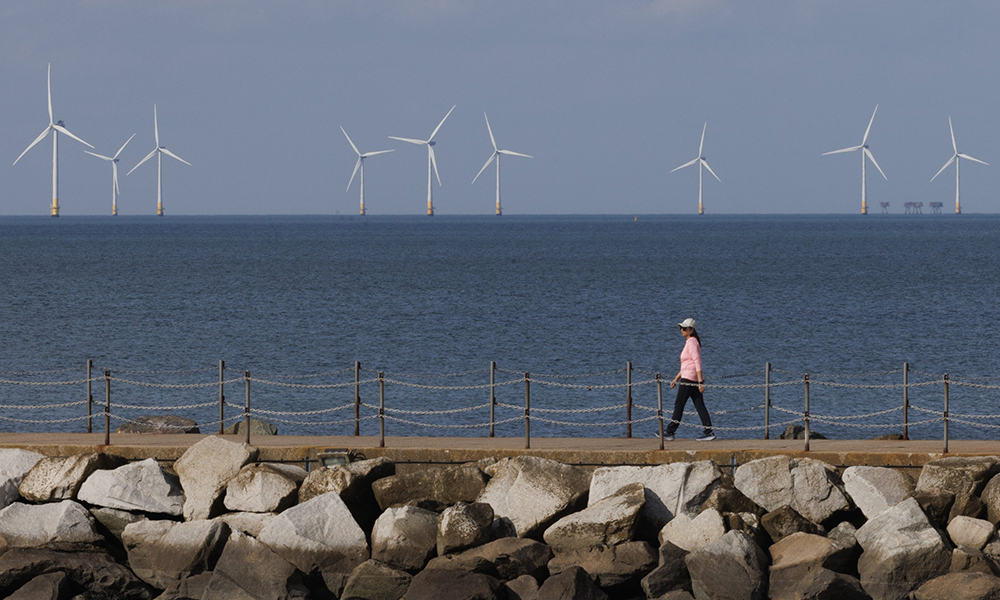2024年宏观经济存在不确定性,但不会妨碍能源转型

第28届联合国气候变化大会(COP28),在失败的边缘取得了非凡的胜利,将被世人所铭记。全世界首次就摆脱所有化石燃料达成了新的共识,110多个国家同意,到2030年将可再生能源产能增加两倍。
本届大会主席苏丹·贾比尔博士促成的这些新承诺,得益于会前长达数月的充分准备和气候变化外交,成为应对气候危机的关键时刻。
在联合国气候变化大会上,我曾多次被问到一个明显的问题,这也是许多人首先会想到的问题,那就是这些宏大的目标是否可行,尤其是在宏观经济充满不确定性的背景下。
要实现这些目标,必须从现在开始行动,因此对可行性的质疑是合理的,要知道从化石燃料向绿色能源转型需要大规模投资。但我坚信,未来六年,这些目标是能够实现的。
成本与效益正在发生变化
国际能源署(IEA)的数据显示,2023年,全球清洁能源投资达到创纪录的1.75万亿美元,而且在支持经济增长的额外能源需求的推动下,预计这种趋势将会持续下去。
如果你打算增加发电容量,从成本、安全性、风险和环境效益方面来评估,可再生能源比任何其他发电技术更有价值。两者之间甚至没有可比性。
在许多发达国家,例如欧盟国家,用可再生能源替代老化的和高污染的化石燃料发电,减少了大规模能源进口,从而改善了收支平衡。可再生能源行业已经证明它能够实现这些宏大的目标。2010年,欧盟启动了20/20/20倡议,当时没有人相信我们能以有意义的方式打破现状,将排放减少20%,将绿色能源在能源系统中的占比提高到当前的水平。但我们证明改变是可行的。
高利率的挑战
与其他所有行业一样,成本上涨也影响了可再生能源行业。最近的可再生能源项目拍卖,例如英国的AR5拍卖,并没有认识到这个事实。在其他情况下,从拍卖结束到实际投资之间存在漫长的前置时间。尤其是对于没有机会对冲成本的公司而言,这就是痛点。
但政策制定者已经做出了反应,他们认识到可再生能源依旧是新增发电容量的最佳途径,并且正在执行新拍卖设计和机制。英国最近公布的AR6海上风力发电机拍卖就是明显的例子。通过设定一个现实的最高价,允许提高供应链成本和贷款利率,将为公司参与竞标和竞争提供恰当的激励。这是过去数十年,可再生能源行业大幅降低成本的基础。
当然,实现COP28设定的目标并非易事,也不会依靠惯性来实现。但宏观经济不确定性或缺乏雄心等并不是关键问题,这些目标能否取得进展,取决于我们能否采取紧急行动,解决过去阻碍我们前进的障碍。其中包括保证稳定和积极的投资框架,简化许可手续,落实真正“绿色的”税务制度,保证全球供应链的稳健和安全,投资绿色技能以推动能源转型,并推广绿色产品消费。
虽然转型规模庞大,但转型已经在进行中。新年伊始,一场“共襄盛举,务实行动”的大会刚刚结束,这场大会组成了一个全球变革联盟,我们有前所未有的机会真正实现能源行业革命。(财富中文网)
本文作者伊格纳西奥·加兰现任伊比德罗拉(Iberdrola)公司的执行董事长。
Fortune.com上发表的评论文章中表达的观点,仅代表作者本人的观点,不能代表《财富》杂志的观点和立场。
翻译:刘进龙
审校:汪皓
第28届联合国气候变化大会(COP28),在失败的边缘取得了非凡的胜利,将被世人所铭记。全世界首次就摆脱所有化石燃料达成了新的共识,110多个国家同意,到2030年将可再生能源产能增加两倍。
本届大会主席苏丹·贾比尔博士促成的这些新承诺,得益于会前长达数月的充分准备和气候变化外交,成为应对气候危机的关键时刻。
在联合国气候变化大会上,我曾多次被问到一个明显的问题,这也是许多人首先会想到的问题,那就是这些宏大的目标是否可行,尤其是在宏观经济充满不确定性的背景下。
要实现这些目标,必须从现在开始行动,因此对可行性的质疑是合理的,要知道从化石燃料向绿色能源转型需要大规模投资。但我坚信,未来六年,这些目标是能够实现的。
成本与效益正在发生变化
国际能源署(IEA)的数据显示,2023年,全球清洁能源投资达到创纪录的1.75万亿美元,而且在支持经济增长的额外能源需求的推动下,预计这种趋势将会持续下去。
如果你打算增加发电容量,从成本、安全性、风险和环境效益方面来评估,可再生能源比任何其他发电技术更有价值。两者之间甚至没有可比性。
在许多发达国家,例如欧盟国家,用可再生能源替代老化的和高污染的化石燃料发电,减少了大规模能源进口,从而改善了收支平衡。可再生能源行业已经证明它能够实现这些宏大的目标。2010年,欧盟启动了20/20/20倡议,当时没有人相信我们能以有意义的方式打破现状,将排放减少20%,将绿色能源在能源系统中的占比提高到当前的水平。但我们证明改变是可行的。
高利率的挑战
与其他所有行业一样,成本上涨也影响了可再生能源行业。最近的可再生能源项目拍卖,例如英国的AR5拍卖,并没有认识到这个事实。在其他情况下,从拍卖结束到实际投资之间存在漫长的前置时间。尤其是对于没有机会对冲成本的公司而言,这就是痛点。
但政策制定者已经做出了反应,他们认识到可再生能源依旧是新增发电容量的最佳途径,并且正在执行新拍卖设计和机制。英国最近公布的AR6海上风力发电机拍卖就是明显的例子。通过设定一个现实的最高价,允许提高供应链成本和贷款利率,将为公司参与竞标和竞争提供恰当的激励。这是过去数十年,可再生能源行业大幅降低成本的基础。
当然,实现COP28设定的目标并非易事,也不会依靠惯性来实现。但宏观经济不确定性或缺乏雄心等并不是关键问题,这些目标能否取得进展,取决于我们能否采取紧急行动,解决过去阻碍我们前进的障碍。其中包括保证稳定和积极的投资框架,简化许可手续,落实真正“绿色的”税务制度,保证全球供应链的稳健和安全,投资绿色技能以推动能源转型,并推广绿色产品消费。
虽然转型规模庞大,但转型已经在进行中。新年伊始,一场“共襄盛举,务实行动”的大会刚刚结束,这场大会组成了一个全球变革联盟,我们有前所未有的机会真正实现能源行业革命。(财富中文网)
本文作者伊格纳西奥·加兰现任伊比德罗拉(Iberdrola)公司的执行董事长。
Fortune.com上发表的评论文章中表达的观点,仅代表作者本人的观点,不能代表《财富》杂志的观点和立场。
翻译:刘进龙
审校:汪皓
COP28 will be remembered as the summit that snatched a remarkable victory from the jaws of defeat. For the first time, the world has new agreed language on transitioning away from all fossil fuels, and more than 110 countries have agreed to triple renewable energy capacity by 2030.
The new commitments brokered by its president, Dr. Sultan al Jaber, were made possible by months of intense preparation and climate change diplomacy in the run-up to the summit, and constitute a pivotal moment in the fight against the climate crisis.
An obvious question I was asked several times at COP, and one that is top of mind for many people, is whether these ambitious goals are feasible, especially against a backdrop of macroeconomic uncertainties.
Given that delivering on the targets needs to start today, the question of feasibility is valid, bearing in mind the sheer scale of investment required to transition away from fossil fuels towards green energy. But I believe emphatically that in the next six years, the goals are achievable.
Costs and benefits are shifting
In 2023 global investment in clean energy reached a record $1.75 trillion, according to the IEA, and this trend is expected to continue to be driven by the need for additional energy sources to support economic growth.
If you want to build new electricity capacity, renewables are better value than any other generation technology in terms of costs, security, risks, and environmental benefits. New versus new, it’s not even a close call.
And by substituting aging and polluting fossil-based generation for renewables, many developed countries, such as those in the EU, are improving the balance of payments by reducing their vast energy imports. The industry has already shown it can meet ambitious targets. When the EU launched the 20/20/20 initiative in 2010, few believed we could disrupt the status quo in a meaningful way to cut emissions by 20% and increase the amount of green energy in the system to current levels. We have proved that change is possible.
The challenge of high interest rates
Cost inflation has affected renewables, as it has all other industrial sectors. Some recent auctions for renewable energy projects–such as the recent AR5 auction in the U.K.–did not recognize this fact. And in other instances, there were long lead times between auctions concluding and the time investments were made. This has created pain points, especially for companies that did not have the chance to hedge their costs.
However, policymakers are already responding, recognizing that renewables remain the best way to secure new electricity capacity, and new auction designs and mechanisms are being put in place. The newly announced AR6 offshore wind turbine auction in the U.K. is a clear example. By setting a realistic maximum price, which allows for increases in supply chain costs and lending rates, companies will have the right incentive to bid and compete. This has been the basis for the massive cost reductions experienced in the renewables sector over decades.
Of course, delivering on the goals set at COP28 will not be easy, nor will it happen by inertia. But rather than macroeconomic issues or lack of ambition, progress rests on urgent action to address the barriers that have held us back in the past. This includes ensuring stable, positive frameworks for investments, simplifying permitting processes, implementing a truly “green” tax system, bolstering global supply chains to ensure they are robust and secure, investing in green skills to drive the energy transition forward, and promoting the consumption of green products.
The transformation may appear massive–but it is already under way. As we embark on a new year, fresh from a “COP for action” that has forged a global alliance for change, we are in the best position ever to deliver a real revolution in energy.
Ignacio Galan is the executive chairman of Iberdrola.
The opinions expressed in Fortune.com commentary pieces are solely the views of their authors and do not necessarily reflect the opinions and beliefs of Fortune.













